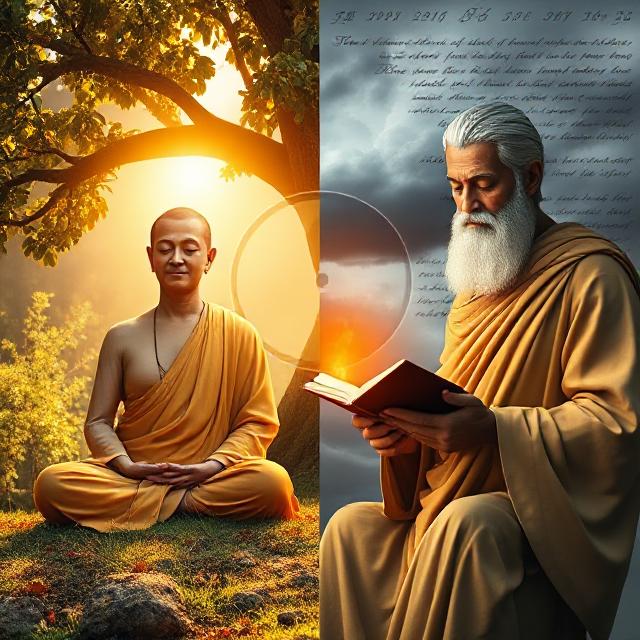
Table of Contents
Mindfulness in Buddhism vs Reason in Stoicism: Two Roads to Inner Mastery
The dialogue between mindfulness in Buddhism vs reason in Stoicism opens a compelling cross-cultural window into how human beings have long sought serenity amidst suffering. Both traditions aim to liberate the mind from destructive impulses, foster clarity, and cultivate a deeper sense of life’s meaning. Yet they approach this goal from remarkably different angles: one through detached awareness of the present moment, the other through rigorous rationality and moral clarity.
At their core, Buddhism and Stoicism are therapies of the soul. Each offers disciplined mental practices, philosophical insight, and transformative habits. But where Buddhism trains attention to dwell in what is, Stoicism trains reason to respond wisely to what happens. Together, they illuminate two ancient yet enduring paths to freedom.
I. Foundations: Different Roots, Common Aims
A. The Origins of Buddhism
Founded in the 5th century BCE by Siddhartha Gautama, Buddhism centers around the Four Noble Truths, which diagnose the human condition:
- Life contains suffering (dukkha)
- Suffering comes from craving and attachment
- There is an end to suffering
- The Eightfold Path leads to liberation
At the heart of the Buddhist path lies mindfulness (sati), a practice of bringing full, nonjudgmental awareness to the present moment. It is both a spiritual tool and a mode of being.
B. The Origins of Stoicism
Stoicism arose in 3rd century BCE Athens with Zeno of Citium, and flourished through thinkers like Epictetus, Seneca, and Marcus Aurelius. Its core tenets include:
- Virtue is the only true good
- Emotions stem from judgments
- What is up to us is our response, not external events
The Stoic ideal is the sage, who lives in harmony with nature through disciplined reason (logos). Stoicism cultivates rational detachment, not indifference.
II. Mindfulness: Buddhist Practice and Psychology
A. What Is Mindfulness?
Mindfulness, in Buddhist practice, is the cultivation of present-centered awareness with acceptance. It means:
- Observing thoughts, emotions, and sensations without clinging or aversion
- Recognizing the impermanence of all things
- Returning gently to the here and now
This awareness interrupts habitual reactivity. It forms the backbone of meditation (especially vipassana) and prepares the mind for deeper insights into emptiness, no-self, and interdependence.
B. Mindfulness as Ethical and Liberating
Mindfulness is not morally neutral. It enables:
- Right action by seeing clearly
- Compassion by feeling others’ pain without attachment
- Freedom by disarming compulsions before they solidify
Thus, mindfulness is not merely stress reduction; it is a path to enlightenment, awakening the practitioner to the nature of reality and breaking cycles of suffering.
III. Reason: The Stoic Path to Peace
A. Rational Judgment and Emotional Control
For Stoics, emotions arise from false beliefs:
- “I need X to be happy”
- “This situation is intolerable”
- “What happened to me is bad”
By correcting these thoughts through reason, we eliminate unhealthy emotions.
“It is not things themselves that disturb us, but our judgments about them.” — Epictetus
Reason allows us to reframe adversity, embrace impermanence, and act from wisdom instead of impulse.
B. The Dichotomy of Control
A hallmark Stoic concept is the dichotomy of control:
- What is up to us: thoughts, choices, intentions
- What is not: the past, others’ actions, external events
Peace arises when we focus on mastering what we can control and accepting the rest with equanimity.
IV. Practical Methods Compared
| Practice | Buddhism: Mindfulness | Stoicism: Reason |
|---|---|---|
| Core Attitude | Awareness and letting go | Analysis and acceptance |
| Tool of Liberation | Meditation, breath, body scan | Journaling, negative visualization |
| View of Emotions | Observe and disidentify | Reframe and realign with virtue |
| Ethics | Compassion, non-harming (ahimsa) | Duty, justice, self-discipline |
| Ultimate Goal | Nirvana: end of suffering | Eudaimonia: flourishing through virtue |
V. Shared Insights and Key Differences
A. Points of Convergence
- Self-mastery: Both traditions see peace as inner mastery, not external success.
- Impermanence: Both accept change as constant and counsel against attachment.
- Discipline: Both encourage daily practice, ethical integrity, and mental training.
B. Fundamental Divergences
- Metaphysics: Stoicism is materialist; Buddhism sees reality as empty of essence.
- Selfhood: Stoicism affirms a rational self; Buddhism deconstructs the very notion.
- Goal of Practice: Stoicism cultivates virtue and civic duty; Buddhism aims at full liberation beyond the cycle of rebirth.
VI. Modern Relevance and Adaptations
A. Mindfulness in the West
Mindfulness has become mainstream in:
- Psychology (e.g., Mindfulness-Based Stress Reduction)
- Education
- Workplaces
Yet, stripped from its ethical and metaphysical roots, it risks becoming just instrumentalized calm—a tool for productivity, not awakening.
B. Neo-Stoicism
Contemporary Stoic revivalists emphasize:
- Emotional resilience
- Cognitive behavioral strategies
- Ethical clarity amid chaos
Apps, online courses, and popular books bring Stoicism into self-help culture, though often omitting its metaphysical rigor.
Conclusion: Presence or Perspective?
The journey through mindfulness in Buddhism vs reason in Stoicism invites us to reflect on two rich paths of human transformation. Where Buddhism says: observe and let go, Stoicism says: analyze and rise above.
Each offers a blueprint for composure, compassion, and clarity. And perhaps, as many modern practitioners find, the deepest wisdom lies in their union: a mind that is both present and principled, awake and wise.
